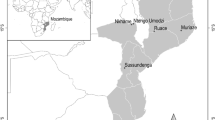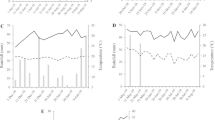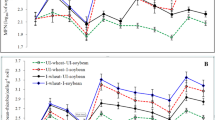Abstract
Plant–microorganism associations have long been studied, but their exploitation in agriculture partially or fully replacing chemical fertilizers is still modest. In this study, we evaluated the combined action of rhizobial and plant growth-promoting rhizobacteria inoculants on the yields of soybean and common bean. Seed inoculation with rhizobia (1.2 × 106 cells seed−1) was compared to co-inoculation with Azospirillum brasilense in-furrow (different doses) or on seeds (1.2 × 105 cells seed−1) in nine field experiments. The best in-furrow inoculant dose was 2.5 × 105 cells of A. brasilense seed−1 for both crops. Inoculation with Bradyrhizobium japonicum increased soybean yield by an average 222 kg ha−1 (8.4 %), and co-inoculation with A. brasilense in-furrow by an average 427 kg ha−1 (16.1 %); inoculation always improved nodulation. Seed co-inoculation with both microorganisms resulted in a mean yield increase of 420 kg ha−1 (14.1 %) in soybean relative to the non-inoculated control. For common bean, seed inoculation with Rhizobium tropici increased yield by 98 kg ha−1 (8.3 %), while co-inoculation with A. brasilense in-furrow resulted in the impressive increase of 285 kg ha−1 (19.6 %). The cheaper, more sustainable inoculated treatment produced yields equivalent to the more expensive non-inoculated + N-fertilizer treatment. The results confirm the feasibility of using rhizobia and azospirilla as inoculants in a broad range of agricultural systems, replacing expensive and environmentally unfriendly N-fertilizers.


Similar content being viewed by others
References
Araújo FF, Hungria M (1999) Nodulação e rendimento de soja co-inoculada com Bacillus subtilis e Bradyrhizobium japonicum/B. elkanii. Pesq Agropec Bras 34:1633–1643
Ashraf MA, Rasool M, Mirza MS (2011) Nitrogen fixation and indole acetic acid production potential of bacteria isolated from rhizosphere of sugarcane (Saccharum officinarum L.). Adv Biol Res 5:348–355
Askary M, Mostajeran A, Amooaghaei R, Mostajeran M (2009) Influence of the co-inoculation Azospirillum brasilense and Rhizobium meliloti plus 2,4-D,4-D on grain yield and N, P, K content of Triticum aestivum (Cv. Baccros and Mahdavi). Am-Eur J Agric Environ Sci 5:296–307
Bárbaro IM, Machado PC, Bárbaro Junior LS, Ticelli M, Miguel FB, Silva JAA (2009) Produtividade da soja em resposta à inoculação padrão e co-inoculação. Colloq Agrar 5:1–7
Baset Mia MA, Shamsuddin ZH, Mahmood M (2010) Use of plant growth promoting bacteria in banana: a new insight for sustainable banana production. Friends Science. Available at: <http://www.fspublishers.org/ijab/past-issues/IJABVOL_12_NO_3/29.pdf>. Accessed 28 July 2012
Bhattacharyya PN, Jha DK (2012) Plant growth-promoting rhizobacteria (PGPR): emergence in agriculture. World J Microbiol Biotechnol 28:1327–1350
Bottini R, Fulchieri M, Pearce D, Pharis R (1989) Identification of gibberelins A1, A3, and iso-A3 in cultures of A. lipoferum. Plant Physiol 90:45–47
Burdman S, Kigel J, Okon Y (1997) Effects of Azospirillum brasilense on nodulation and growth of common bean (Phaseolus vulgaris L.). Soil Biol Biochem 29:923–929
Campo RJ, Araujo RS, Hungria M (2009) Nitrogen fixation with the soybean crop in Brazil: compatibility between seed treatment with fungicides and bradyrhizobial inoculants. Symbiosis 48:154–163
Campo RJ, Araujo RS, Mostasso FL, Hungria M (2010) In-furrow inoculation of soybeans as alternative for fungicides and micronutrients seed treatment and inoculation. Rev Bras Ci Solo 34:1103–1112
Chaparro JM, Sheflin AM, Manter DK, Vivanco JM (2012) Manipulating the soil microbiome to increase soil health and plant fertility. Biol Fertil Soils 48:489–499
Dashti NH, Montasser MS, Ali NY, Bhardwaj RG, Smith DL (2007) Nitrogen biofixing bacteria compensate for the yield loss caused by viral satellite RNA associated with cucumber mosaic virus in tomato. Plant Pathol J 23:90–96
Döbereiner J, Pedrosa FO (1987) Nitrogen-fixing bacteria in non-leguminous crop plants. Springer, Madison
Egamberdieva D, Berg G, Lindström K, Räsänen LA (2010) Co-inoculation of Pseudomonas spp. with Rhizobium improves growth and symbiotic performance of fodder galega (Galega orientalis Lam.). Eur J Soil Biol 46:269–272
Fehr WR, Caviness CE (1977) Stages of soybean development. Iowa State University, Ames
Graham PH (1981) Some problems of nodulation and symbiotic nitrogen fixation in Phaseolus vulgaris L.: a review. Field Crop Res 4:93–112
Hamaoui B, Abbadi JM, Burdman S, Rashid A, Sarig S, Okon Y (2001) Effects of inoculation with Azospirillum brasilense on chickpeas (Cicer arietinum) and faba beans (Vicia faba) under different growth conditions. Agronomie 21:553–560
Hungria M, Vargas MAT (2000) Environmental factors impacting N2 fixation in legumes grown in the tropics, with an emphasis on Brazil. Field Crop Res 65:151–164
Hungria M, Andrade DS, Chueire LMO, Probanza A, Guttierrez-Mañero FJ, Megías M (2000) Isolation and characterization of new efficient and competitive bean (Phaseolus vulgaris L.) rhizobia from Brazil. Soil Biol Biochem 32:1515–1528
Hungria M, Campo RJ, Mendes IC (2003) Benefits of inoculation of the common bean (Phaseolus vulgaris) crop with efficient and competitive Rhizobium tropici strains. Biol Fertil Soils 39:51–61
Hungria M, Franchini JC, Campo RJ, Graham PH (2005) The importance of nitrogen fixation to soybean cropping in South America. In: Newton WE (ed) Nitrogen fixation: origins, applications and research progress, v.4, Werner W, Newton WE (Ed) Nitrogen fixation in agriculture, forestry, ecology and the environment. Springer, Dordrecht, Amsterdam, pp 25–42
Hungria M, Campo RJ, Mendes IC, Graham PH (2006a) Contribution of biological nitrogen fixation to the N nutrition of grain crops in the tropics: the success of soybean (Glycine max L. Merr.) in South America. In: Singh RP, Shankar N, Jaiwa PK (eds) Nitrogen nutrition and sustainable plant productivity. Stadium Press, Houston, pp 43–93
Hungria M, Franchini JC, Campo RJ, Crispino CC, Moraes JZ, Sibaldelli RNR, Mendes IC, Arihara J (2006b) Nitrogen nutrition of soybean in Brazil: contributions of biological N2 fixation and of N fertilizer to grain yield. Can J Plant Sci 86:927–939
Hungria M, Campo RJ, Souza EM, Pedrosa FO (2010) Inoculation with selected strains of Azospirillum brasilense and A. lipoferum improves yields of maize and wheat in Brazil. Plant Soil 331:413–425
Itzigsohn R, Kapulnik Y, Okon Y, Dovrat A (1993) Physiological and morphological aspects of interactions between Rhizobium meliloti and alfalfa (Medicago sativa) in association with Azospirillum brasilense. Can J Microbiol 39:610–615
Klute A (ed) (1986) Methods of soil analysis, part 1, physical and mineralogical methods 2nd edition. American Society of Agronomy, Madison, 1358pp
Kumar R, Chandra R (2008) Influence of PGPR and PSB on Rhizobium leguminosarum bv. viciae strain competition and symbiotic performance in lentil. World J Agric Sci 4:297–301
Lima AST, Barreto MCS, Araújo JM, Seldin L, Burity HA, Figueiredo MVB (2011) Sinergismo Bacillus, Brevibacillus e, ou, Paenibacillus na simbiose Bradyrhozobium-caupi. Rev Bras Ci Solo 35:713–721
Martínez-Viveros O, Jorquera MA, Crowley DE, Gajardo G, Mora ML (2010) Mechanisms and practical considerations involved in plant growth promotion by rhizobacteria. J Soil Sci Plant Nutr 10:293–319
Massoud ON, Morsy EM, El-Batanony NH (2009) Field response of snap bean (Phaseolus vulgaris L.) to N2-fixers Bacillus circulans and arbuscular mycorrhizal fungi inoculation through accelerating rock phosphate and feldspar weathering. Aust J Basic Appl Sci 3:844–852
Peres JRR, Mendes IC, Suhet AR, Vargas MAT (1993) Eficiência e competitividade de estirpes de rizóbio para a soja em solos de Cerrados. R Bras Ci Solo 17:357–363
Remans R, Ramaekers L, Schelkens S, Hernandez G, Garcia A, Reyes JL, Mendez N, Toscano V, Mulling M, Galvez L, Vanderleyden J (2008) Effect of Rhizobium–Azospirillum coinoculation on nitrogen fixation and yield of two contrasting Phaseolus vulgaris L. genotypes cultivated across different environments in Cuba. Plant Soil 312:25–37
Rodriguez H, Gonzalez T, Goire I, Bashan Y (2004) Gluconic acid production and phosphate solubilization by the plant growth-promoting bacterium Azospirillum spp. Naturwissenschaften 91:552–555
SAS Institute (2001) Proprietary of software, version 8.2, 6th edn. SAS, Cary
Sparks DL (ed) (1996) Methods of soil analysis, part 3, chemical method. American Society of Agronomy, Madison, 1264 p
Stajković O, Delić D, Jošić D, Kuzmanović Đ, Rasulić N, Knežević-Vukčević J (2011) Improvement of common bean growth by co-inoculation with Rhizobium and plant growth-promoting bacteria. Romanian Biotechnol Lett 16:5919–5926
Strzelczyk E, Kamper M, Li C (1994) Cytocinin-like-substances and ethylene production by Azospirillum in media with different carbon sources. Microbiol Res 149:55–60
Tien TM, Gaskins MH, Hubbell DH (1979) Plant growth substances produced by Azospirillum brasilense and their effect on the growth of pearl millet (Pennisetum americanum L.). Appl Environ Microbiol 37:1016–1024
Vargas MAT, Mendes IC, Hungria M (2000) The response of field grown Phaseolus vulgaris to Rhizobium inoculation and nitrogen fertilization in two Cerrado soils. Biol Fertil Soils 32:228–233
Vincent JM (1970) Manual for the practical study of root nodule bacteria. Blackwell, Oxford (International Biological Programme Handbook, 15)
Wang S, Huijun W, Junqing Q, Lingli M, Jun L, Yanfei X, Xuewen G (2009) Molecular mechanism of plant growth promotion and induced systemic resistance to tobacco mosaic virus by Bacillus spp. J Microbiol Biotechnol 19:1250–1258
Yadegari M, Asadi Rahmani H (2010) Evaluation of bean (Phaseolus vulgaris) seeds’ inoculation with Rhizobium phaseoli and plant growth promoting Rhizobacteria (PGPR) on yield and yield components. Afr J Agric Res 5:792–799
Zullo J Jr, Pinto HS, Assad ED, Evangelista SRM (2008) Potential economic impacts of global warming on two Brazilian commodities according to IPCC prognostics. Terrae 3:28–39
Acknowledgments
The study was partially supported by CNPq (Conselho Nacional de Desenvolvimento Científico e Tecnológico, Brazil), CNPq-Microrganismos Facilitadores (557746/2009-4), CNPq-Repensa (562008/2010-1) and CNPq-CAPES-Science without Borders (UEL-Embrapa Soja- ICGEB). M. Hungria, M. A. Nogueira, and R. S. Araujo are also research fellows from CNPq.
Author information
Authors and Affiliations
Corresponding author
Rights and permissions
About this article
Cite this article
Hungria, M., Nogueira, M.A. & Araujo, R.S. Co-inoculation of soybeans and common beans with rhizobia and azospirilla: strategies to improve sustainability. Biol Fertil Soils 49, 791–801 (2013). https://doi.org/10.1007/s00374-012-0771-5
Received:
Revised:
Accepted:
Published:
Issue Date:
DOI: https://doi.org/10.1007/s00374-012-0771-5




